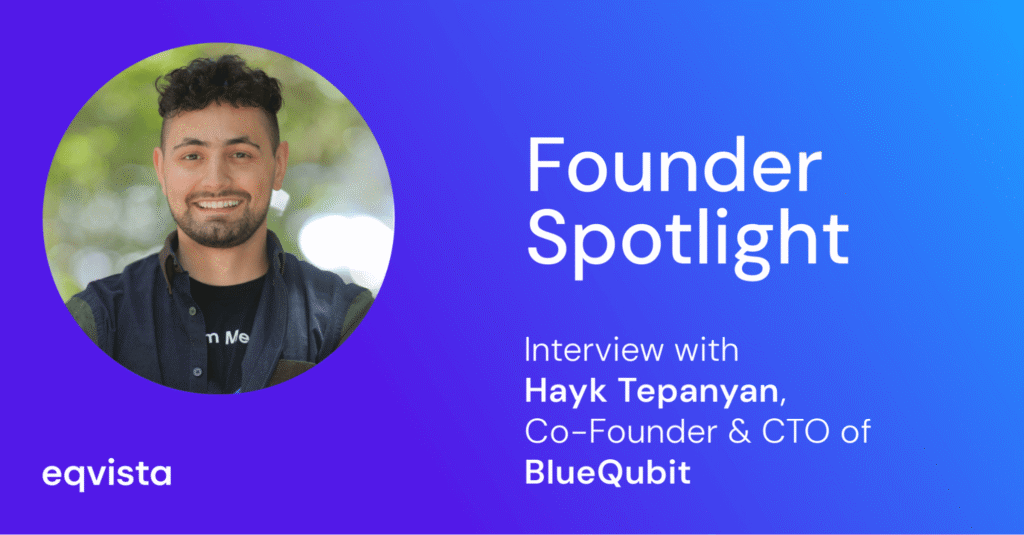Interview With Hayk Tepanyan, Co-Founder and Chief Technology Officer of BlueQubit
Welcome to another edition of Founder Spotlight with Hayk Tepanyan, Co-Founder and Chief Technology Officer (CTO) of BlueQubit, a quantum software and algorithms company. Hayk leads the technical vision and development of BlueQubit’s platform, which aims to democratize access to quantum computing by making it user-friendly for developers and researchers.BlueQubit’s applications are particularly relevant in fields like quantum chemistry and molecular dynamics, where quantum computers can provide significant advantages over classical systems. BlueQubit, under Tepanyan’s technical leadership, is positioned as a key player in making quantum computing more accessible and practical for a broad range of users.

Hello Hayk, Welcome to Founder Spotlight! Can you share your journey from working at Google to co-founding BlueQubit? What motivated you to venture into the quantum computing space as an entrepreneur?
My journey from Google to co-founding BlueQubit was driven by a deep fascination with the future of computing. During my time at Google, I was fortunate to work on cutting-edge projects that exposed me to the power and potential of emerging technologies. However, I kept feeling drawn to the uncharted territory of quantum computing, where we could push boundaries even further. The idea of harnessing quantum mechanics to solve incredibly complex problems captivated me—it felt like discovering a new frontier of innovation.
That excitement soon transformed into a full-on entrepreneurial drive. I wanted to build something from the ground up that would directly contribute to quantum computing’s evolution. With my background in computer science and my passion for turning ambitious ideas into real-world impact, co-founding BlueQubit felt like the perfect next step. It’s been a thrilling journey so far, and we’re just scratching the surface of what’s possible in the quantum realm.
As the quantum computing market is expected to experience substantial growth in the coming years, what specific strategies does BlueQubit intend to implement to take full advantage of this expanding landscape?
We believe that timing and focus are everything in this rapidly evolving market. One of our key strategies is to deeply partner with enterprises that are starting to explore quantum solutions, offering them a clear roadmap and hands-on expertise to identify high-impact use cases. By tailoring our software solutions to solve real-world problems and demonstrating near-term value, we can build confidence among potential customers and continually grow demand for quantum capabilities.
Additionally, we’re investing heavily in continuous R&D and collaboration with the broader quantum community. We actively seek to co-develop and test new algorithms that are optimized for the constraints of current and near-term quantum hardware. By staying at the forefront of both foundational research and practical, market-driven applications, we aim to keep BlueQubit agile and responsive to the ever-evolving quantum ecosystem.
What steps is BlueQubit taking to position itself as a leader in the quantum computing space, particularly in transforming sectors like finance and pharmaceuticals?
We’re focused on developing specialized quantum software and algorithms tailored to high-value industry applications. By partnering closely with leading organizations in finance and pharmaceuticals—areas where quantum computing can offer immediate competitive advantages—we can rigorously validate our solutions and ensure they generate real-world impact. Our commitment to cutting-edge research and collaboration with hardware providers positions BlueQubit as a front-runner in delivering tangible, transformative outcomes in these critical sectors.
What are the primary technical challenges that BlueQubit developing its Quantum Software as a Service (QSaaS) platform?
A major hurdle lies in bridging the gap between complex quantum hardware constraints—like noise, limited qubits, and short coherence times—and delivering a robust, user-friendly software layer. We’re also navigating the integration of classical computing resources with quantum systems for hybrid solutions. On top of that, quantum hardware is evolving rapidly, requiring us to continually adapt our platform to new architectures and keep refining our error mitigation and algorithmic strategies.

Can you discuss any specific use cases where BlueQubit has successfully helped enterprises transition from classical to quantum computing?
Currently, full-scale transitions from classical to quantum computing hinge on achieving quantum advantage—a milestone we believe is on the near horizon. Our R&D efforts are laser-focused on identifying and refining use cases where quantum can deliver a clear performance edge so the move beyond classical approaches is justified. While we’re not at the point of full replacement yet, our pilot projects are laying the groundwork by tackling specific computational bottlenecks in areas like optimization and materials simulation. These early successes not only showcase quantum’s near-term potential but also position us—and our enterprise partners—to rapidly adopt quantum solutions once true advantage is demonstrated.
What areas of quantum computing do you believe hold the most promise for innovation and commercial application in the near future?
Optimization and simulation stand out as the near-term heavyweights, especially for industries like finance and pharmaceuticals where even small computational improvements can mean massive cost savings and new discoveries. There is also the vertical of quantum AI and Quantum Machine Learning that is promising faster or lighter predictive models in the future. These areas not only demonstrate tangible value in today’s market, but also showcase the transformative potential of quantum technologies as they continue to mature and scale.
Congrats for raising a $10 million seed funding round! What specific advancements or features do you plan to develop with the new funding?
We plan to channel the new funding into further enhancing our Quantum Software as a Service platform, specifically by expanding our support for hybrid classical-quantum workflows, and deepening our integrations with various quantum hardware providers. We’ll also invest in building specialized teams focused on near-term quantum advantage, working on algorithmic breakthroughs that can tackle real-world challenges in industries like finance and pharmaceuticals. By accelerating product development and scaling our R&D efforts, we aim to deliver tangible, enterprise-ready solutions that showcase quantum computing’s transformative potential.
How will you ensure your cap table stays well-structured as BlueQubit grows? Do you have specific lessons learned regarding managing the cap table and equity distribution, in a rapidly evolving industry such as quantum computing?
Maintaining a clean, well-structured cap table starts with open communication and carefully considered equity allocations from day one. We’ve put a premium on aligning incentives—not only among founders and early team members, but also with strategic investors who understand the unique growth trajectory of quantum computing. By consistently revisiting our equity strategy at each funding milestone and ensuring transparent record-keeping, we reduce potential conflicts, attract the right partners, and stay nimble enough to adapt as new opportunities arise in this rapidly evolving field.
As a leader, what advice would you give to young engineers or entrepreneurs looking to enter the field of quantum technology?
My biggest piece of advice is to build a solid foundation in both quantum mechanics and classical computing—understand the science before jumping into applications. From there, seek out hands-on projects or open-source collaborations that push you to solve real quantum computing challenges. Don’t be afraid to learn from every experiment, whether it succeeds or fails; the field is evolving so quickly that adaptability is key. And finally, focus on collaborating across disciplines. The most impactful quantum breakthroughs often arise at the intersection of physics, computer science, and domain-specific expertise, so cultivate diverse skill sets and networks.
